|
|
The Relief Organization
engaged in an eight-year policy of vilifying Turks, from 1915 to 1923.
Professor Justin McCarthy
Prof.
McCarthy tells us more
about the Near East Relief
---------------------------
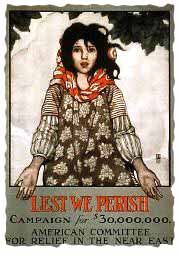 |
|
"Lest
We Perish"
|
President
Woodrow Wilson concurred and also encouraged the formation of the organization
known as Near East Relief, chartered by an Act of Congress, which contributed
over $113,000,000 from 1915 to 1930 to aid Armenian survivors. (Peter
Balakian wrote in "The Burning Tigris" the amount would be worth
around one billion dollars today. In an interview, he claimed $2.5 billion.
Here is another example of half-
Balaked numbers.)
The
Armenian Refugees (Lord Mayor's) Fund was the smaller counterpart charity set
up in Great Britain.
Holdwater, here: When I started this page, it was
really to highlight the wonderful photographs I discovered of the period, and
I confused the goings-on with the Near East Relief (although some of the
documentation is relief-oriented.) The Near East Relief issue deserves a much
better page exploring what lay behind it, and so far this is not it. However,
I will be adding more direct Near East Relief information, as such comes my
way.
For example:
Here
is how an American
colonel reacted, when he was the High Commissioner for Relief... which I
presume was associated with the Near East Relief. (In this other report, where the
colonel's reaction is equally fierce, it's said he was with the Red Cross.)
This page features photographs
taken by Francis W. Kelsey during his Near East Expedition of 1919-1920. It is
from a web site with the following description:
In 1919, University of Michigan
professor Francis W. Kelsey launched an expedition to Europe and the Near
East. He was seeking to acquire early Christian manuscripts and photograph
sites of archaeological interest. This exhibit contains a collection of images
taken during the expedition. Contextual information about the expedition and
individual photographs is also provided.
Francis
W. Kelsey was a professor of classics and archeology. He seemed to be
fascinated by ethnic types, given the mug shots he took of the area's
residents. He traveled pretty extensively.
These photos are of interest to see
how the Armenians were coping a few years after the violence and resettlement.
Agenda of the Near East
Relief
By the end of October, the late
Miss Annie T. Allen and Miss Florence Billings, the Near East Relief's
representatives in Ankara (Angora), compiled a report on the state of
the Turkish villages which the Greeks had burned during their retreat
and forwarded it to the Near East Relief's headquarters in
Constantinople. But the Near East Relief has never published that
report, just as Mr. Lloyd George never published the Bristol report on
Greek misdeeds at Izmir (Smyrna)
Clair Price, The Rebirth of
Turkey, New York 1923 (p. 189)
|
|
|
|
| Francis W. Kelsey
and the Near East Expedition of 1919-1920 |
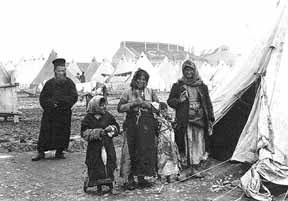 |
|
"Priest and some refugees, many of the refugee
tents
in the background." |
| How do you suppose that priest survived? I would have
thought the Christian-hating Turks would have targeted them first, in their feeding
frenzy. |
|
|
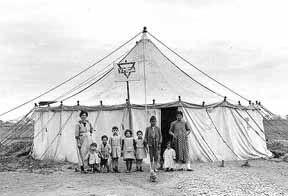 |
|
"A part of the Armenian refugee camp. Some
children
in front of the tent." |
| That's the "YMCA" logo on top of the tent.
The Armenians sure owe the Americans a debt of gratitude for taking care of them
this way. Their Turkish countrymen were not having a picnic at this time. |
|
|
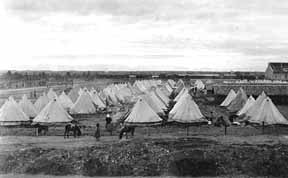 |
|
"General view of part of Armenian refugee camp
at Adana.
Armenians were moved here from Aleppo. Tents
were "ditched" and comfortably dry." |
| These Armenians were brought in from
Syria, where they had been sent to resettle. Seems to me like a good healthy chunk
survived, for a people to have been nearly wiped out. |
|
(The white strip at
right, by the house, is a row of more tents.) |
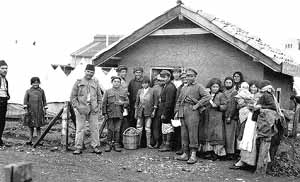 |
|
"Line up of refugees for the bread ration." |
| Only women, children and old men were left, we're
sometimes told. Where did these younger fellows come from? |
|
|
|
The
Prettiest Armenian Girl "Anywhere"
|
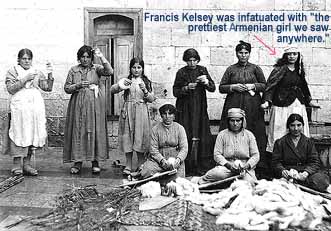 |
|
"Nine of the older girls and women working on
cotton. The Armenian girl
in the back row, at the extreme right, was the prettiest Armenian
girl we saw anywhere." |
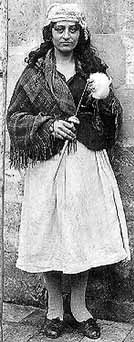 |
|
"The prettiest Armenian girl we saw. With
distaff in hand, shawl on shoulders, sort of cap on head" |
| Well, here she is, in a
closer view, at left. What
do you think? Hmmmm.
Not to say Armenian women
can't be beautiful, but I don't
know why the professor got
so bent out of shape over
this lass. |
|
|
 |
|
A better
representation of
good looking Armenian womanhood.
(Hasmik Mardirosian, best model from
Armenia in 2001, by dreamstage7.com) |
|
| Demir Delen, in his observations of the film, ARARAT:
The message given is that because the film was based on a
book written by Clarence Ussher, an
American, it must be reliable and historically correct. This is the proof of
"Armenian genocide." Mr. Ussher was a Protestant missionary in Van in 1915.
The Armenian campaign of the American Board of Commissioners for Foreign Missions (ABCFM)
was their most successful missionary campaign. This campaign collected $116,000,000
based on the propaganda of slaughter of Christians by evil Turks (Muslims). If one
calculates this in today's money, this would be the most successful private charity
campaign in U.S. history. Mr. Ussher wrote his book on 1917 in Boston and published it
before the U.S. entered the war. It was in the missionaries' interest to write a
propaganda book depicting only the Armenian suffering, ignoring completely the Muslim
deaths and suffering. The raising of funds depended on helping Armenian victims. The
more the victims, the more the funds.
Holdwater: The fact that these
missionaries ignored Moslem suffering and singled out solely the Armenians made them pseudo-Christians. Aside from
the breaking of a couple of commandments, like bearing false witness against a
neighbor. |
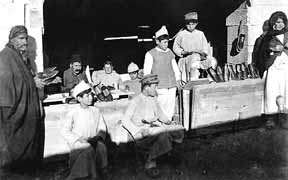 |
|
"Shoe shop run by orphan boys. We would call
slippers
what they call shoes." |
| "We would call slippers what they would call
shoes." Well, excuse me, Mr. High and Mighty American! |
|
|
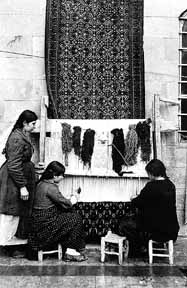 |
|
"Three Armenian girls and the rug they
were working on. The rug above is not
the one being made -- just hung up to
show. The one being woven shows
below. At Miss Kelley's." |
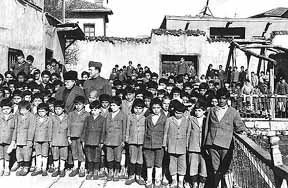 |
|
"Maj. Arnold, Miss Cushman, and scores of orphan
children,
not the younger ones. Under Miss Cushman's charge." |
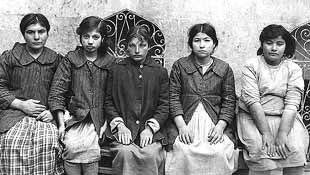 |
|
"Five Armenian girls whose cheeks and chins had
been tattooed
in blue by their former Arab owners. Tattooing does not show
nearly so plainly in the picture as it did to the eye." |
This is the most "incriminating" photo in the lot ... these girls were
tattooed by their "former Arab owners." During my research for this site, I came
across mention of this oddball tattooing custom once, and the Turks were (naturally)
accused of doing the tattooing. Nowhere in my knowledge banks did I ever come across a
fondness for tattooing by Turks, and that seemed suspicious to me. Now, thanks to this
description, I surmise this is an Arab thing.
As far as the "Arab owners" business, that implies Arabs (like I've heard so
often about Turks, through all the wild genocide claims) took these girls in as slaves. Is
that true? I'm not saying there wouldn't have been some unscrupulous creeps who took
advantage of others' misfortune, when they got half the chance; but perhaps the Arabs took
these stranded girls and helped care for them... and maybe the tattooing was one of the
strange things people of other cultures do... that we in the West have a way of sniffing
at.
I really don't know... it's possible these Arabs were the horrible slave-owners the
description implies. The one thing that raises my eyebrows here (besides my knowledge of
the Christian community of this period making all sorts of accusations to show the Moslem
people in this part of the world to be evil and barbaric) is ... if Arabs took these girls
in as slaves, how could so many of these girls (there are five here, but no doubt there
were more) have escaped their masters' evil clutches? Isn't it the job of an
"owner" to hold on to his property? I doubt the authorities would have gone on a
house-to-house search to reclaim these girls, and even if they did, any slave owner worth
his salt would know how to stash away his property. Could it be the word "owner"
was used with malice? The book is still open for me on this one.
To get a terrific overview on what lay behind the Relief
Organization (they weren't just a charitable organization, but had a mean agenda in mind),
headed by James Barton (who wrote the reply
to the famous Mark Bristol letter), please visit the excellent presentation Professor
McCarthy gave on the subject, where the link was provided above.
See Also:
Missionaries
Mission
Work Reports
|
|